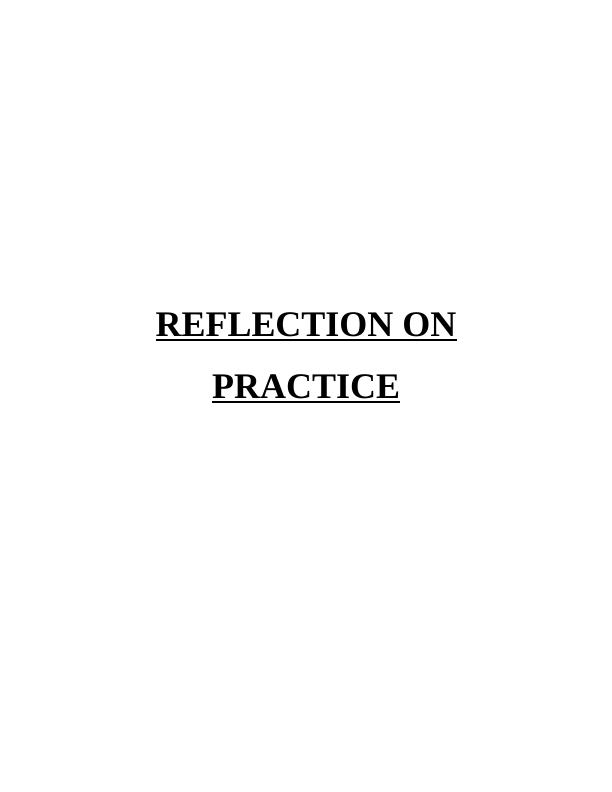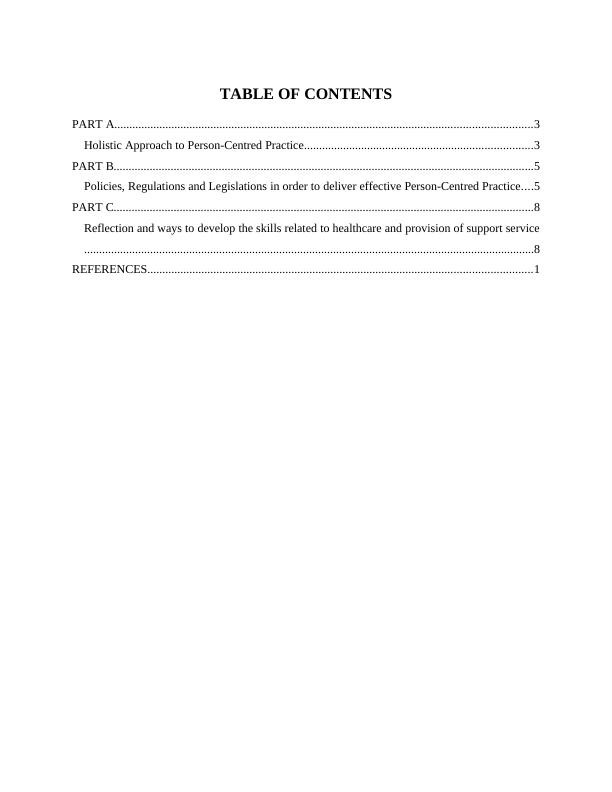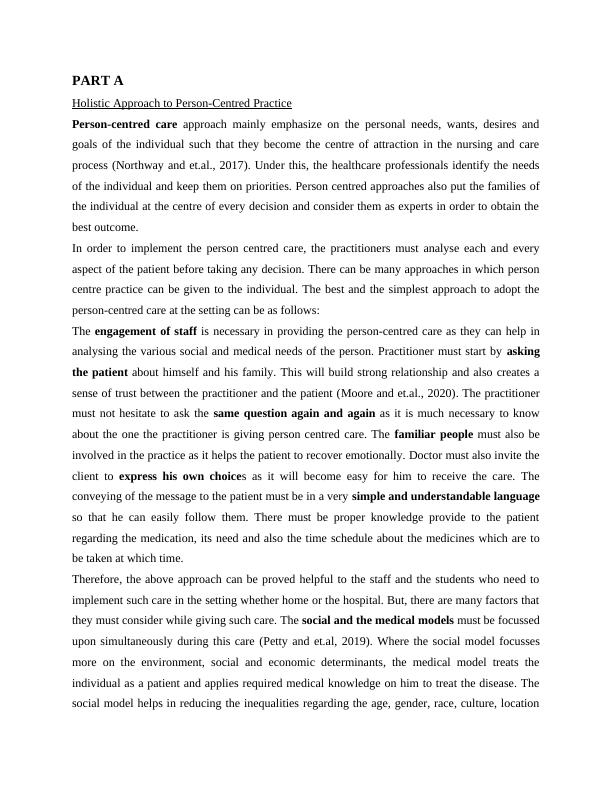Reflection on Practice
Added on 2023-01-06
15 Pages4772 Words2 Views
REFLECTION ON
PRACTICE
PRACTICE

TABLE OF CONTENTS
PART A...........................................................................................................................................3
Holistic Approach to Person-Centred Practice............................................................................3
PART B............................................................................................................................................5
Policies, Regulations and Legislations in order to deliver effective Person-Centred Practice....5
PART C............................................................................................................................................8
Reflection and ways to develop the skills related to healthcare and provision of support service
......................................................................................................................................................8
REFERENCES................................................................................................................................1
PART A...........................................................................................................................................3
Holistic Approach to Person-Centred Practice............................................................................3
PART B............................................................................................................................................5
Policies, Regulations and Legislations in order to deliver effective Person-Centred Practice....5
PART C............................................................................................................................................8
Reflection and ways to develop the skills related to healthcare and provision of support service
......................................................................................................................................................8
REFERENCES................................................................................................................................1

PART A
Holistic Approach to Person-Centred Practice
Person-centred care approach mainly emphasize on the personal needs, wants, desires and
goals of the individual such that they become the centre of attraction in the nursing and care
process (Northway and et.al., 2017). Under this, the healthcare professionals identify the needs
of the individual and keep them on priorities. Person centred approaches also put the families of
the individual at the centre of every decision and consider them as experts in order to obtain the
best outcome.
In order to implement the person centred care, the practitioners must analyse each and every
aspect of the patient before taking any decision. There can be many approaches in which person
centre practice can be given to the individual. The best and the simplest approach to adopt the
person-centred care at the setting can be as follows:
The engagement of staff is necessary in providing the person-centred care as they can help in
analysing the various social and medical needs of the person. Practitioner must start by asking
the patient about himself and his family. This will build strong relationship and also creates a
sense of trust between the practitioner and the patient (Moore and et.al., 2020). The practitioner
must not hesitate to ask the same question again and again as it is much necessary to know
about the one the practitioner is giving person centred care. The familiar people must also be
involved in the practice as it helps the patient to recover emotionally. Doctor must also invite the
client to express his own choices as it will become easy for him to receive the care. The
conveying of the message to the patient must be in a very simple and understandable language
so that he can easily follow them. There must be proper knowledge provide to the patient
regarding the medication, its need and also the time schedule about the medicines which are to
be taken at which time.
Therefore, the above approach can be proved helpful to the staff and the students who need to
implement such care in the setting whether home or the hospital. But, there are many factors that
they must consider while giving such care. The social and the medical models must be focussed
upon simultaneously during this care (Petty and et.al, 2019). Where the social model focusses
more on the environment, social and economic determinants, the medical model treats the
individual as a patient and applies required medical knowledge on him to treat the disease. The
social model helps in reducing the inequalities regarding the age, gender, race, culture, location
Holistic Approach to Person-Centred Practice
Person-centred care approach mainly emphasize on the personal needs, wants, desires and
goals of the individual such that they become the centre of attraction in the nursing and care
process (Northway and et.al., 2017). Under this, the healthcare professionals identify the needs
of the individual and keep them on priorities. Person centred approaches also put the families of
the individual at the centre of every decision and consider them as experts in order to obtain the
best outcome.
In order to implement the person centred care, the practitioners must analyse each and every
aspect of the patient before taking any decision. There can be many approaches in which person
centre practice can be given to the individual. The best and the simplest approach to adopt the
person-centred care at the setting can be as follows:
The engagement of staff is necessary in providing the person-centred care as they can help in
analysing the various social and medical needs of the person. Practitioner must start by asking
the patient about himself and his family. This will build strong relationship and also creates a
sense of trust between the practitioner and the patient (Moore and et.al., 2020). The practitioner
must not hesitate to ask the same question again and again as it is much necessary to know
about the one the practitioner is giving person centred care. The familiar people must also be
involved in the practice as it helps the patient to recover emotionally. Doctor must also invite the
client to express his own choices as it will become easy for him to receive the care. The
conveying of the message to the patient must be in a very simple and understandable language
so that he can easily follow them. There must be proper knowledge provide to the patient
regarding the medication, its need and also the time schedule about the medicines which are to
be taken at which time.
Therefore, the above approach can be proved helpful to the staff and the students who need to
implement such care in the setting whether home or the hospital. But, there are many factors that
they must consider while giving such care. The social and the medical models must be focussed
upon simultaneously during this care (Petty and et.al, 2019). Where the social model focusses
more on the environment, social and economic determinants, the medical model treats the
individual as a patient and applies required medical knowledge on him to treat the disease. The
social model helps in reducing the inequalities regarding the age, gender, race, culture, location

and the socio-economic status as equity plays a major role in health service delivery. The
medical model analyses the symptoms of the patient which is referred to as illness and strives
hard to eradicate it. Both the models need to be addressed by the practitioner as physical and
mental health of the person are equally important.
Though implementing such care is believed to produce the best positive results but after
considering all such factors also, the practitioner faces wide variety of challenges which are to
be meet up in order to deliver effective person-centred care. The main challenge faced is to keep
an eye on the patient constantly. It becomes more difficult when there is much work load on the
practitioners which divert them in any way (Riachi, 2018). This could be solved by prioritizing
the works as keeping the person centred care on the top priority and others after that as the
patient is the first and foremost responsibility. The another issue can be created when the patient
becomes uncooperative. It becomes very difficult for the doctor to provide care to the patient
which is best in the eyes of the doctor but the patient is not ready to receive it. This creates a
sense of distrust among them which hinders the improvement. In order to resolve this problem,
the master must create a sense of loyalty by asking the patient the same question more than 2
time in order to know more about him. The doctor must also aware the patient about the need of
the care and how it can be helpful in improving the overall health. The lack of resources also
becomes the issue while delivering such care (Barber, Saunders and Barnett, 2018). In this
instance, the practitioner must not affect the care and the practice but make the best use of the
available resources and must inform the other departments of the settings to provide the
necessary resources within the time-frame. The another challenge can be faced when the patient
makes choices which are harmful for him and the practitioner cannot allow doing so. In this case,
the practitioner must not force the patient to go according to him but must be ready with the
choice of the patient after considering all the factors (McCormack and McCance, 2016). The
recognition that the person had expertise and knowledge that is required to be taken into account
is better option. Therefore, the approach mentioned above proves to be the best way to
implement the person-centred care in which the social and medical determinants are also
addressed. It is considered to be the holistic approach which can be taught to the staff in order to
adopt such practice.
Dilemmas faced in implementing effective person-centred care
medical model analyses the symptoms of the patient which is referred to as illness and strives
hard to eradicate it. Both the models need to be addressed by the practitioner as physical and
mental health of the person are equally important.
Though implementing such care is believed to produce the best positive results but after
considering all such factors also, the practitioner faces wide variety of challenges which are to
be meet up in order to deliver effective person-centred care. The main challenge faced is to keep
an eye on the patient constantly. It becomes more difficult when there is much work load on the
practitioners which divert them in any way (Riachi, 2018). This could be solved by prioritizing
the works as keeping the person centred care on the top priority and others after that as the
patient is the first and foremost responsibility. The another issue can be created when the patient
becomes uncooperative. It becomes very difficult for the doctor to provide care to the patient
which is best in the eyes of the doctor but the patient is not ready to receive it. This creates a
sense of distrust among them which hinders the improvement. In order to resolve this problem,
the master must create a sense of loyalty by asking the patient the same question more than 2
time in order to know more about him. The doctor must also aware the patient about the need of
the care and how it can be helpful in improving the overall health. The lack of resources also
becomes the issue while delivering such care (Barber, Saunders and Barnett, 2018). In this
instance, the practitioner must not affect the care and the practice but make the best use of the
available resources and must inform the other departments of the settings to provide the
necessary resources within the time-frame. The another challenge can be faced when the patient
makes choices which are harmful for him and the practitioner cannot allow doing so. In this case,
the practitioner must not force the patient to go according to him but must be ready with the
choice of the patient after considering all the factors (McCormack and McCance, 2016). The
recognition that the person had expertise and knowledge that is required to be taken into account
is better option. Therefore, the approach mentioned above proves to be the best way to
implement the person-centred care in which the social and medical determinants are also
addressed. It is considered to be the holistic approach which can be taught to the staff in order to
adopt such practice.
Dilemmas faced in implementing effective person-centred care

End of preview
Want to access all the pages? Upload your documents or become a member.
Related Documents
Understanding the Models of Healthlg...
|9
|2388
|24
Practice Development: Person-Centered Carelg...
|7
|889
|227
Patient-Centered and Culturally Safe Care Research Paper 2022lg...
|10
|3011
|18
Professional Practice Model - Nursinglg...
|5
|913
|15
Individual Differences and Abnormal Psychology Essaylg...
|20
|7131
|1
Holistic Approachlg...
|4
|697
|85
